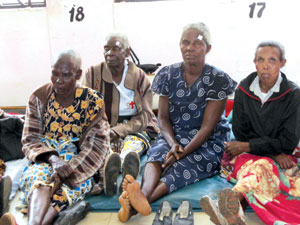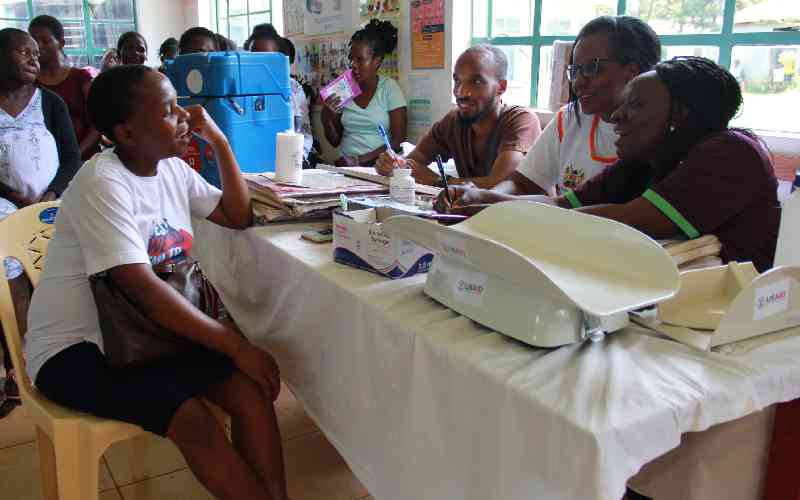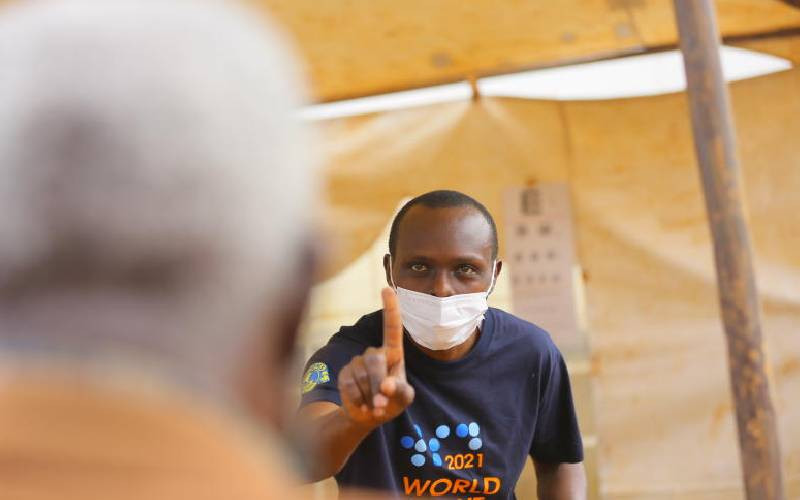By ROBERT NYASATO
For the last two years, octogenarian Nyabonyi Orina has literally seen nothing but darkness.
Initially, her sight was good until a strange ache hit her: that is when she started to gradually lose her sight. “My right eye started to ache. I treated it as a simple itch but eventually I could not see anymore.” Ms Nyabonyi who hails from Riokindo village in Kenyenya District, Kisii County recounted.
When her condition worsened, she sought medical attention and was issued with eyeglasses to regain her sight. But she still could not see. Later while on a visit to Hema Hospital in Kisii town with a different ailment, she was diagnosed with cataract (locally known as chikenge). This is a medical condition that leads to blindness.
Medics describe cataract as clouding that develops in the crystalline lens of the eye or in its envelope (lens capsule). It varies in degree, from slight to complete opacity, and obstructs the passage of light. “I was in the ward undergoing medication when doctors informed me about a free eye camp at the hospital. When I went for screening they diagnosed my condition and put me on the list of beneficiaries,” Nyabonyi told The Standard On Saturday. The 80-year-old is now a happy grandmother after regaining her sight courtesy of the Kisii Eye Camp where doctors fixed her condition.
Annual camp
She was among 165 beneficiaries who successfully underwent cataract operations at the hospital last month during a three-day free eye camp sponsored by the Rotary Club of Nairobi in collaboration with Hema Hospital.
 |
|
Some cataract patients who turned up for the Kisii Eye Camp at Hema hospital in Kisii town. [PHOTOS: ROBERT NYASATO/STANDARD] |
“I never knew this problem had a cure until I underwent the procedure myself. Now I can differentiate between a man and woman. However, I am still unable to dress myself well,” she said.
A collection of walking sticks at the hospital is testimony of how many people came blind but went home seeing again after undergoing cataract operations. Hema Hospital Chairman Hezron Manduku says they have been hosting the annual camp for the last 10 years.
Dr Manduku says the procedure takes about 10 to15 minutes and can cost a whopping Sh30,000 for just one eye – an amount that is far beyond the reach of most Kenyans.
Honorary Rotarian, Mukesh Joshi, organiser of the exercise said 500 people from Kericho, Homabay, Kapsabet and Kisii were diagnosed with cataracts. However, owing to financial constraints, they managed to fix only 165 patients. Some 3000 patients were screened but priority was given to those who had cataracts in two eyes.
The camp organisers gave priority to patients with cataracts in both eyes for lack of funds.
The eye camp dubbed ‘cataract extraction’ is partly sponsored by Kenya Ear Association, Dr Manu D’cruz and Dr Manu Chandaria. Christened Kenya Rural Blindness Eradication Project, Rotary Club of Nairobi has been performing free cataract operations in rural areas for the last 25 years.
Financial limitations
Dr Joshi and his team have performed more than 14,000 free cataract operations and over 100 free corneal transplants during the period.
Stay informed. Subscribe to our newsletter
The only challenge the doctors are faced with in their project to restore sight of suffering Kenyans is financial limitations.
Other teammates are Rotarian Salim Fazal (Co-ordinater), Rotarian David Hastie (Financial Controller), Ophthalmologists Dr Jafferji of Kikuyu Eye Hospital and Dr Onsomo of Nakuru. The club is also doing free Corneal Transplant for keratoconus Patients. Keratoconus is a disease characterised by the cornea coming out of shape. If not treated on time the cornea can perforate, giving rise to white cornea, a condition known as hydrops.
Potentially blinding
The doctors have made a major breakthrough in technology of Corneal Transplant assisted by laser also known as Laser Assisted Corneal Transplant (LACT) for the first time in Africa and Asia.
Lact is where 1000Htz laser will remove the irregular cornea and leave the patient’s thin layer of the cornea behind. In a similar way, the donor’s cornea is sculpted by the laser such that it will match like a jig-saw puzzle. The cornea is fitted on the recipient and a few stitches inserted.
The club has embarked on a new project in conjunction with the Swiss Embassy of doing Laser Assisted Corneal Transplants for poor patients. Most cataracts are due to age-related changes in the lens of the eye. Possible signs of cataracts include blurriness in one’s field of vision; poor colour or contrast sensitivity and sensitivity to light.
Early in the development of age-related cataracts, the power of the lens may be increased, causing near-sightedness (myopia).
The gradual yellowing and opacification of the lens may reduce the perception of blue colours. Cataracts typically progress slowly to cause loss of vision, and are potentially blinding if left untreated.
The condition usually affects both eyes; but almost always, one eye is affected earlier than the other.
 The Standard Group Plc is a
multi-media organization with investments in media platforms spanning newspaper
print operations, television, radio broadcasting, digital and online services. The
Standard Group is recognized as a leading multi-media house in Kenya with a key
influence in matters of national and international interest.
The Standard Group Plc is a
multi-media organization with investments in media platforms spanning newspaper
print operations, television, radio broadcasting, digital and online services. The
Standard Group is recognized as a leading multi-media house in Kenya with a key
influence in matters of national and international interest.
 The Standard Group Plc is a
multi-media organization with investments in media platforms spanning newspaper
print operations, television, radio broadcasting, digital and online services. The
Standard Group is recognized as a leading multi-media house in Kenya with a key
influence in matters of national and international interest.
The Standard Group Plc is a
multi-media organization with investments in media platforms spanning newspaper
print operations, television, radio broadcasting, digital and online services. The
Standard Group is recognized as a leading multi-media house in Kenya with a key
influence in matters of national and international interest.






